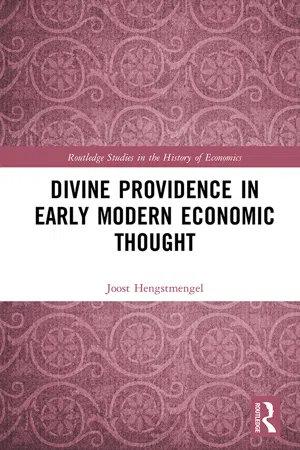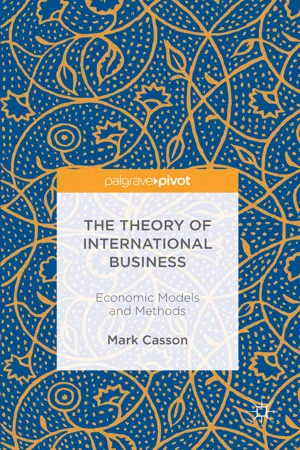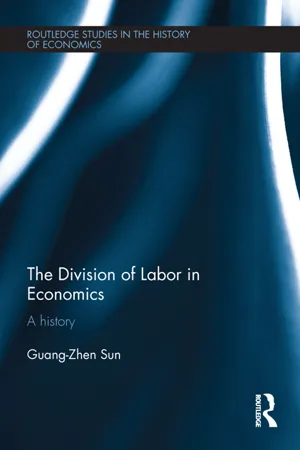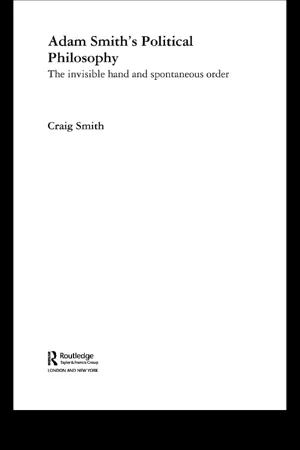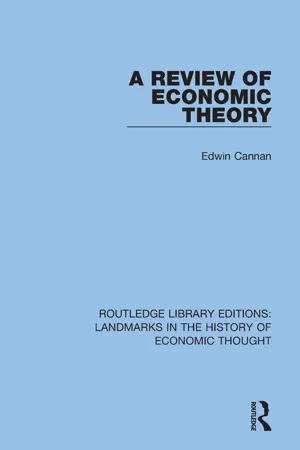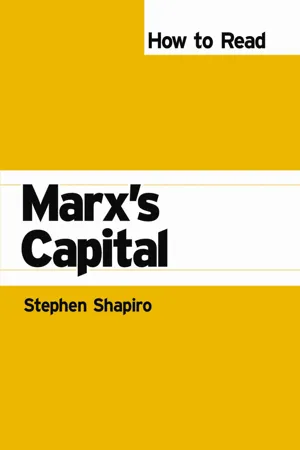Economics
Specialisation and Division of Labour
Specialisation and division of labour refer to the process of individuals or businesses focusing on specific tasks or activities within the production process. This allows for increased efficiency and productivity as each participant can develop expertise in their area of specialisation, leading to overall economic growth and improved resource allocation.
Written by Perlego with AI-assistance
Related key terms
Related key terms
1 of 4
Related key terms
1 of 3
8 Key excerpts on "Specialisation and Division of Labour"
- Joost Hengstmengel(Author)
- 2019(Publication Date)
- Routledge(Publisher)
4 Division of labourThe divine ordering of society
Introduction
The division of labour, or the separation and distribution of tasks among different persons, is a central concept in economics. On hearing the term, most economists will immediately think of Adam Smith,1 and unsurprisingly so, for the most-cited and most-reproduced text sections in the history of economic thought come from the first three chapters of his The Wealth of Nations , which are devoted to this topic. Although the unprecedented nature of the book is sometimes exaggerated, the association of the division of labour with the Scotsman is fully justified. As compared to his predecessors, Smith covered the matter in great detail and by opening the book with the division of labour, he elevated it to one of the core principles of his political economy. ‘It is the great multiplication of the productions of all the different arts, in consequence of the division of labour,’ Smith established, ‘which occasions, in a well-governed society, that universal opulence which extends itself to the lowest ranks of the people’.2 Simultaneously contributing to an increase in skill and dexterity, saving of time, and the invention of machinery, the division of labour is one of the foundations of the wealth of nations.It is often overlooked that Smith discussed three different types of division of labour. The best-known example from the opening chapter is undoubtedly that of the pin-making factory. By specializing in one or a few of the eighteen distinct tasks of this craft, the productivity of a group of ten workers increases from about 200 to 48,000 pins a day. This is an instance of the ‘manufacturing’ or ‘technical division of labour’, i.e. specialization within an occupation or industry. Another kind, to which Smith pays as much attention, is the ‘social division of labour’. It refers to the more general separation of professions and employments within human society. By specializing in distinct occupations and by exchanging the fruits of their labour, Smith argued, people can enjoy more goods and services than when they tried to perform all tasks themselves. In the third place, he discussed the ‘international’ or ‘territorial division of labour’, the tendency of countries to specialize in specific industries. Smith refrained from mentioning a fourth kind, to wit the ‘sexual division of labour’, the distribution of tasks within the household between man and woman based on their natural abilities.3- eBook - ePub
Foundations of Organisational Economics
Histories and Theories of the Firm and Production
- Paul Walker(Author)
- 2021(Publication Date)
- Routledge(Publisher)
The division of labour and the theory of the firmIntroduction
George Stigler argues that the division of labour should be seen as integral to the theory of the firm.The division of labor is not a quaint practice of eighteenth-century pin factories; it is a fundamental principle of economic organization. (Stigler 1951: 193)But while the division of labour is an ancient idea in economics, it did not spark discussion about the firm until relatively recently.This chapter examines the influence (or lack of influence) that the analysis of the division of labour has had on mainstream economic thinking to do with the theory of the firm/theory of production.1 It will be shown that despite the division of labour being a very old idea in economics, dating from at least the ancient Indians, Greeks and Chinese, it took more than two thousand years for it to give rise to a theory of the firm. Following on from the ancient scholars, in the medieval period both Islamic and Christian theologians and philosophers analysed the concept and consequences of the division of labour. The pre-classical, classical and neoclassical economists continued and expanded the enquiry, but all without applying the division of labour to the theory of the firm.It was not until the twentieth century that a division of labour based theory of the firm finally appeared. In the 1920s Lawrence Frank saw an increasing division of labour as giving rise to the vertically integrated firm. In the 1930s E. A. G. Robinson argued that the division of labour affected the size of the firm due to its effects on production technology and management. By the 1950s George Stigler was arguing that the size of the firm was limited by the division of labour due to the division of labour being limited by the extent of the market. In the 1990s Gary Becker and Kevin Murphy saw the size of the firm as being limited not just by the size of the market but also, more often, by coordination costs. In 2018 Michael Rauh showed that the division of labour, which translates to the size of the firm, can be, depending on circumstances, limited by the extent of the labour market, moral hazard or an ‘O-ring’ property. In this paper Rauh utilises a stochastic or ‘O-ring’ production function. Importantly, with an O-ring production function, if one part of the production process fails, the whole process fails. - eBook - ePub
The Theory of International Business
Economic Models and Methods
- Mark Casson(Author)
- 2016(Publication Date)
- Palgrave Macmillan(Publisher)
© The Editor(s) (if applicable) and the Author(s) 2016 Mark Casson The Theory of International Business 10.1007/978-3-319-32297-1_5 Begin Abstract 5. Division of Labour and Modularisation Mark Casson 1 (1) Department of Economics, University of Reading, Reading, UK Abstract The division of labour is a central concept in international business (IB), although it is sometimes known by other names. Its significance was first noted by the eighteenth-century-economist Adam Smith. He defined it as the sub-division of a complex task into a set of simpler tasks that can be performed by unskilled labour or machines. In IB different tasks are often carried out at different locations. Marketing and research and development can be separated from production, and upstream and downstream production can be separated too. Separate activities can be carried out in different countries. This chapter examines the gains from the international division of labour and shows how the optimal division of labour in any sector or industry can be analysed in economic terms. Keywords Division of labour Modularisation Transport cost Product development Technology transfer End Abstract Introduction The division of labour is one of the oldest concepts in economics. In the Wealth of Nations, Adam Smith argued that the division of labour encourages the employment of specialised workers and the mechanisation of certain jobs, and thereby increases productivity. He described the division of labour in terms of the modularisation of production. Modularisation replaces a single complex task requiring a scarce combination of skills with a set of simpler tasks requiring skills that are much easier to acquire. Simple tasks can be performed more quickly; they are therefore repeated more often and so are easier to learn - eBook - ePub
The Division of Labor in Economics
A History
- Guang-Zhen Sun(Author)
- 2013(Publication Date)
- Routledge(Publisher)
1 The notion of increasing returns to the division of labor has therefore been referred to as generalized increasing returns (Buchanan 1994), the macroeconomic concept of increasing returns (Currie 1997, prepared by Roger Sandilands), the network effect of the division of labor (e.g., Yang 2001; Lavezzi 2003) and other terms, all of which deliberately emphasize the subtle yet fundamental difference from the effect generated from scale of operation by a particular productive unit such as a firm.Given its multi-faceted nature, the subject of the social division of labor has of course received a great deal of attention, not only from economists. As was long ago observed by the ancient Chinese, Greeks and Islamic scholars (see Chapter 2 ), the civilization of a human society, and even its survival, rests on the division of the tasks in production and the appropriate distribution of output among its members. The enormous benefits and profound implications of the division of labor can therefore hardly be overstated. The genesis and the mechanism of specialization and the division of labor, especially in early development of human society, have been also examined by anthropologists and ethnologists, often in very rich archaeological and historical detail.2 For our purpose, what is of special interest in these studies is the origins and organizational forms of specialization in the relatively primitive stages of socio-economic development, which stand in sharp contrast to the very complex web of the division of labor comprising at least dozens of thousands of different kinds of jobs that we have nowadays. In particular, anthropologists distinguish, by the institutional affiliation of the craft specialists, between independent specialists who produce goods and services for the market wherein the demand cannot be ex ante - eBook - ePub
- Craig Smith(Author)
- 2006(Publication Date)
- Routledge(Publisher)
5 The science of political economy
The division of labour
As we have seen, the use and transferral of knowledge is one of the key elements in the Scots’ understanding of the nature of social progress.1 This is clearly exemplified by Smith’s analysis of the concept of the division of labour. As Smith famously begins the Wealth of Nations: ‘The greatest improvement in the productive powers of labour, and the greater part of the skill, dexterity, and judgement with which it is any where directed, or applied, seem to have been the effects of the division of labour’ (WN: 13). It is through his analysis of the division of labour that Smith explains the phenomenon which results in a situation where the most ordinary labourer in a commercial society has more material resources, is better provided for, than the monarch of a savage or undeveloped country (WN: 24). But more than this, though Smith’s famous example of the productive improvements of the division of labour in the manufacturing of pins (WN: 14) graphically illustrates the material benefits of the process, he was also keen to stress the social implications of the division and the wealth which it generates. Indeed Smith goes so far as to state that civilization itself is dependent on the division of labour: he writes: ‘In an uncivilized nation, and where labour is undivided’ (LJP: 489). This juxtaposition of civilization with the division of labour indicates how central the concept is to his theory of society and social progress.The division of labour is central to civilization but it is the result of a process of unintended consequences. As Smith would have it: the division of labour ‘is not originally the effect of any human wisdom, which foresees and intends that general opulence to which it gives occasion’ (WN: 23); rather ‘it is the necessary, though very slow and gradual consequences’ (WN: 23) of the interaction of human nature with the circumstances in which it finds itself: in brief it is the result of the growth of experiential knowledge (LJP: 570–1). Again and again Smith stresses that the division of labour is not the product of purposive or deliberative human action guided by rational analysis. He claims that: ‘No human prudence is requisite to make this division’ (LJP: 351), and that ‘This division of work is not however the effect of any human policy’ (LJP: 347). - eBook - ePub
Adam Smith's Economics
Its Place in the Development of Economic Thought
- Maurice Brown(Author)
- 2013(Publication Date)
- Routledge(Publisher)
5 Specialisation and Social Change: The Division of Labour DOI: 10.4324/9780203092743-5It has been suggested already that Smith, in common with the other members of the Scottish Historical School, regards the economic organisation of society as being a fundamental determinant of many of its other attributes. Now, when we come to examine this proposition in detail it will be seen that it is in need of a more precise specification; for Smith it is the way human labour is organised which shapes society. This proposition in its static form I have called Smith’s ‘labour theory of value’ (see Chapter 2 ), but it will here be examined in its dynamic form, in terms of the division of labour.Let us begin with basics by looking at what Smith has to say about the causes of economic growth. In his Introduction (Section 4) to the Wealth of Nations he isolates two factors. Firstly, the productivity of labour increases with the growing ‘skill, dexterity and judgement’ of the labourer, and secondly, the proportion of productive labourers who are engaged in what Smith calls ‘useful labour’ gradually increases.Smith regards the first of these as being the most important, for as he points out, in many primitive societies, virtually everyone is productively employed, despite which per capita product is at, or at times below, subsistence level. He directly links increases in productivity with a progressive division of labour, this being a consequence of his general perspective which views socioeconomic development in terms of the application of labour to the raw materials provided by nature. Viewed from this perspective, changes in the level of national income are seen as changes in the productivity of that labour as specialisation develops. This indeed is the theme of all of Book I of the Wealth of Nations - eBook - ePub
- Edwin Cannan(Author)
- 2016(Publication Date)
- Routledge(Publisher)
And should anyone undertake to provide a coat only, by going himself through the various operations of shearing the wool, carding, spinning, weaving, tucking, etc., half the labour and toil in his own particular profession would not only have equipped him with a better garment, but also procured him other necessaries. Besides the great incumbrance of tools that would be requisite for the finishing of most things from the beginning, it would be next to impossible for any one man either to find time or to acquire skill sufficient for the making of all those tools; he would soon find himself at a loss, and under a necessity of seeking the aid of others” (pp. 17–18). Adam Smith’s account of the division of labour, though so famous, is not remarkable for originality nor even for completeness in the exposition of what had already been discovered. Both in the lectures and in the Wealth of Nations only three advantages of division of labour are given: (1) the increase of dexterity in the specialised workman, (2) the saving of time spent in passing from one kind of work to another, and (3) the increase of invention owing to work being simplified. Smith damaged his exposition of the first of these by a too exclusive insistence on mere manual dexterity in the performance of simple operations, although he was aware that the specialisation of persons to different occupations and even to different sciences was important. Similarly in regard to the third advantage, he greatly overstressed the importance of invention by manual workers who see that their simple jobs might be done by a machine, forgetting that the invention of such a machine is anything but popular among those whose labour it is to supersede. He omitted altogether the economy of tools and the possibility of localising industries so as to get the most good from the different qualities of different places - eBook - ePub
- Stephen Shapiro(Author)
- 2008(Publication Date)
- Pluto Press(Publisher)
This kind of division occurs when ‘tribes’ increasingly come into contact with each other to trade commodities. When groups routinely trade, they often create a division of tasks, so that the group can continue to make the use-values that it needs to survive as well as exchangeable commodities. The most basic ‘foundation’ for every division of labour beyond these early ones is ‘the separation of town from country’ (472). In passing, Marx says that ‘the whole economic history of society is summed up in the movement of this antithesis’ between the urban and the rural. We can think of this not simply as a division within one country, but also as a way to describe international divisions between the West and the developing ‘Third World’. Marx says that the distinction between the city and the countryside is ‘relative’ so that a ‘thinly populated country, with well-developed means of communication, has a denser population than a more numerously populated country with badly developed means of communication. In this sense, the northern states of the U.S.A. for instance, are more thickly populated than India’ (473). Despite the surface similarities between the divisions of labour that take place ‘in the interior of society’ and those taking place in the ‘interior of a workshop’ (474), these divisions are different, not only in degree, but also in kind. In society, the divisions of labour relate to subjects who make an entire commodity. In manufacture, ‘the specialized worker produces no commodities’ (475), since he now only generates a fraction of a commodity. The division of labour in society occurs through the buying and selling between ‘different branches of industry’, while the division of labour in a manufactory is controlled by a single capitalist entity planning the entire work process
Index pages curate the most relevant extracts from our library of academic textbooks. They’ve been created using an in-house natural language model (NLM), each adding context and meaning to key research topics.
Explore more topic indexes
Explore more topic indexes
1 of 6
Explore more topic indexes
1 of 4
